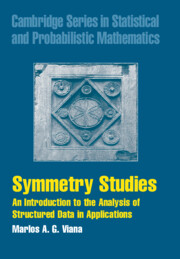Book contents
- Frontmatter
- Contents
- Preface
- 1 Symmetry, Classification, and the Analysis of Structured Data
- 2 Sorting the Labels: Group Actions and Orbits
- 3 Connecting Symmetries and Data: Linear Representations
- 4 Data Reduction and Inference: The Canonical Projections and Their Invariants
- 5 Examples and Techniques
- 6 Symmetry Studies of Short Symbolic Sequences
- 7 Symmetry Studies of Curvature Data
- 8 Symmetry Studies of Planar Chirality
- Appendix A Computing Algorithms
- Appendix B Glossary of Selected Symbols, Notations, and Terms
- Bibliography
- Index
8 - Symmetry Studies of Planar Chirality
Published online by Cambridge University Press: 06 July 2010
- Frontmatter
- Contents
- Preface
- 1 Symmetry, Classification, and the Analysis of Structured Data
- 2 Sorting the Labels: Group Actions and Orbits
- 3 Connecting Symmetries and Data: Linear Representations
- 4 Data Reduction and Inference: The Canonical Projections and Their Invariants
- 5 Examples and Techniques
- 6 Symmetry Studies of Short Symbolic Sequences
- 7 Symmetry Studies of Curvature Data
- 8 Symmetry Studies of Planar Chirality
- Appendix A Computing Algorithms
- Appendix B Glossary of Selected Symbols, Notations, and Terms
- Bibliography
- Index
Summary
Introduction
Chirality is a term coined by Lord Kevin meant to designate the quality of “any geometrical figure, or group of points of which a plane mirror image, ideally realized, cannot be brought to coincide with itself.” The handedness in molecules was first identified by Pasteur and since then the investigation of its presence, effects, and quantification in the natural sciences has received continued interest.
For example, molecular chirality is a necessary and sufficient condition for a substance to exibit optical activity, a property discovered by Huygens in 1690 when studying a crystal of calcite. Optically active substances are capable of rotating the plane of polarization of a ray of plane polarized light. The presence of the symmetry of an improper rotation (an axial rotational followed by reflection on a plane orthogonal to the axis of rotation) in a molecule is a sufficient condition for its nonchirality as its mirror image created by the plane of reflection, after a rotation, is superimposable. In particular, molecules with the symmetry of a planar reflection or with point symmetry are achiral and hence optically inactive.
Many molecules such as amino acids and sugars are chiral, which in turn can cause DNA molecules to be chiral. The differential effect of the two pairs becomes observable only in the presence of a collective of chiral molecules, or by probing the pair with circularly polarized light, which is in itself a chiral mechanism. Planar chirality adds the constraint that the (planar and bounded) objects cannot be lifted from the plane, and consequently, the allowed symmetry operations are restricted to planar transformations.
- Type
- Chapter
- Information
- Symmetry StudiesAn Introduction to the Analysis of Structured Data in Applications, pp. 201 - 220Publisher: Cambridge University PressPrint publication year: 2008

